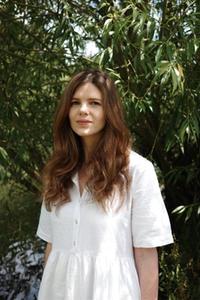 |
|
| Xenobe Purvis (photo: Michael Guppy) |
|
Xenobe Purvis was born in Tokyo in 1990. She studied English Literature at the University of Oxford, has an MA in creative writing from Royal Holloway, and was part of the London Library's Emerging Writers Programme. Her essays have been published in the Times Literary Supplement, the London magazine, and elsewhere. Her riveting debut novel, The Hounding (Holt, August 5, 2025), set at the turn of the 18th century, in the midst of heat and drought, centers on five girls and rumors swirling that they are transforming into dogs.
Did your book begin with a character, or with the setting, or perhaps that 1701 letter from Dr. John Friend in Philosophical Transactions of the Royal Society, which serves as a kind of epigraph to your novel?
At the heart of this book is the kernel of a true story, which I have adapted for my own means. John Friend (or Freind; he seemed to use both) was a physician who treated five sisters in Oxfordshire in 1700--the girls were "seized with frequent barking." He published his findings in Philosophical Transactions of the Royal Society, the world's oldest science journal, still running today. I was intrigued to imagine the response of a small village to such a strange--and possibly dangerous--phenomenon. Seemingly "possessed" children held rare power in a society in which they had few rights, especially if they were girls. I wanted to explore the dynamics at work in such a situation, as well as introduce a kind of Angela Carter-ish suggestion that the sisters were not merely behaving like dogs but might actually be turning into them too.
My story is an imaginative response to Friend's case, but I was determined to make it feel as real as possible, from the clothes the sisters would have worn, to the food they could have eaten. I plundered probate records and other sources from their village and found a family of five sisters whose dates were coherent with those of the girls in Friend's report; I borrowed their first names for my characters. The book is full of other colourful findings from that time; anything that strikes you as strange or unbelievable is probably true. Out of all that reading grew a vivid cast of characters, a setting, and a plot!
From the beginning of the novel, readers feel a sense of foreboding. Not just because of that stunning opening scene with its mention of the "murdered man's fate," but especially the villagers "angry about the weather and their failing crops and shallow wells"--who seem to seek a scapegoat. How did you maintain that sense of impending tragedy?
The prologue was written later and really heightens the dramatic tension, but I was careful to weave that feeling of foreboding in right from the first page. It's there in the weather--this ominous heatwave, a ticking time-bomb because a drought means the drunkard ferryman will be out of work. There is also plenty of foreshadowing: the badger-baiting, for instance, which shows us early on the awful blood-lust of the villagers.
The novel seamlessly moves through close third-person chapters that center on a single point of view and return to several of the characters. Yet not one chapter centers on any of the sisters' viewpoints. Why did you make that choice?
Keeping the narrative voice removed from the sisters' perspectives was a technical necessity. If the engine of the narrative was the question of what actually happened to the girls, then it seemed an inescapable fact that we could never access their point of view. That lack of clarity felt important to me. I really wanted to underline the messy violence of rumours and misinformation, so needed to establish shifting, sometimes conflicting, perspectives. The "voicelessness" of the girls in a story ostensibly about them also felt significant: they are powerless in shaping their own narrative.
Pete Darling's desire to be a good Christian wrestles with his desire for Anne, and his desire for her mutates into rage that overtakes him as an obsession. Can you talk a bit about the development of Pete's character, and those two poles pulling at him?
Pete Darling represents the bad righteous man--to my mind among the most dangerous of all men, because he believes his actions are divinely authorised and because he gives the impression of goodness. A wolf in sheep's clothing. At his heart, he is a lustful, rageful person, but he feels legitimised by apparent visitations from angels and messages from God in his dreams. Still, despite this critique of Pete's religious hypocrisy, I tried to leave space for small moments of magic and miracles in the book. I wasn't necessarily trying to privilege reason over religion.
Is it possible that Pete's own animal instincts influence him to think of the girls as shape changers who can become wild dogs?
Very possibly. There is a wildness about Pete, which I also tried to reflect in the imagery I used to describe him--comparisons to weather and predatory animals. It makes him an intriguing foil to the girls.
As Pete leaves his own wedding ceremony, thinking he hears the Mansfield girls barking outside the church, Robin observes "a hunger in the air, a lust, which would only end in violence." Robin and Temperance, who has never tasted ale until Pete forces her fingers into his cup, take risks at tremendous costs to themselves. Is anyone safe in a world such as this?
No, is the short answer. Everyone--even someone as pure as Robin--can be corrupted. Or let's say changed. The image I had most in mind while writing was of metamorphosis. There's the central metamorphosis, of course--the idea of the girls possibly turning into dogs. But in each of the peripheral characters I also wanted to introduce a change: from "good" to "bad," from abstinence to drunkenness, from unseeing to seeing, and so on. Nothing is fixed. Everything is uncertain.
Anne seems to see the world most clearly. She says to her grandfather, "[W]e were too free, and this--all of this--is our punishment. It has nothing to do with the idea of us becoming dogs, and everything to do with the fact of us being girls." Do you think that is still true today?
I believe this is a truth that is still keenly felt by many girls today. I tried to inhabit that misogyny while writing the sections that closely follow Pete the ferryman's perspective. He is frustrated by many things, but he is truly enraged by girls and women who don't submit to the patriarchal order. That anger--that incredulous rage--still seems to me to inform much of today's misogyny.
Robin's line is so insightful, too: "He felt, as he always did with village gossip, that the gossiper not only gave but took; something was required by the listener." Robin is the truthteller, but even he gets sucked into the village's vortex, doesn't he?
He does. It felt necessary to me that Robin should be sucked in. He's our moral compass, our beacon of profound goodness; if he is corrupted what hope do the rest of us have? I also wanted to explore the oppressive effect of patriarchy on all members of society--boys as well as girls. It's clear how the violent patriarchy of the village affects the girls, but I hoped to show how damaging it could be for the boys too. --Jennifer M. Brown

